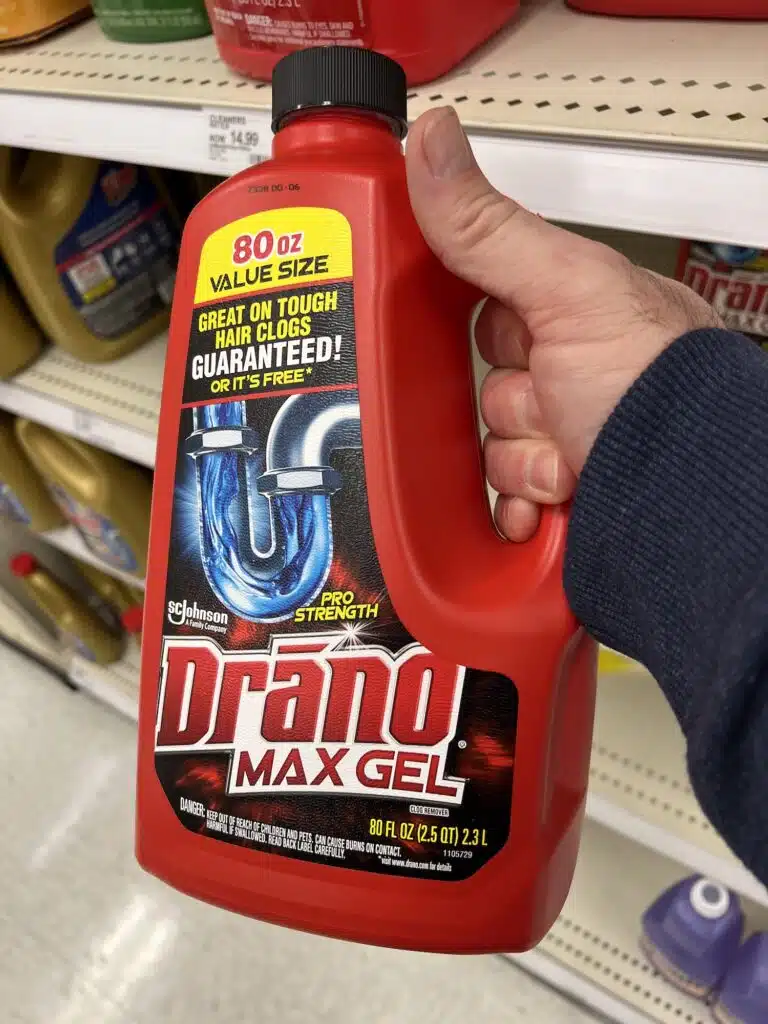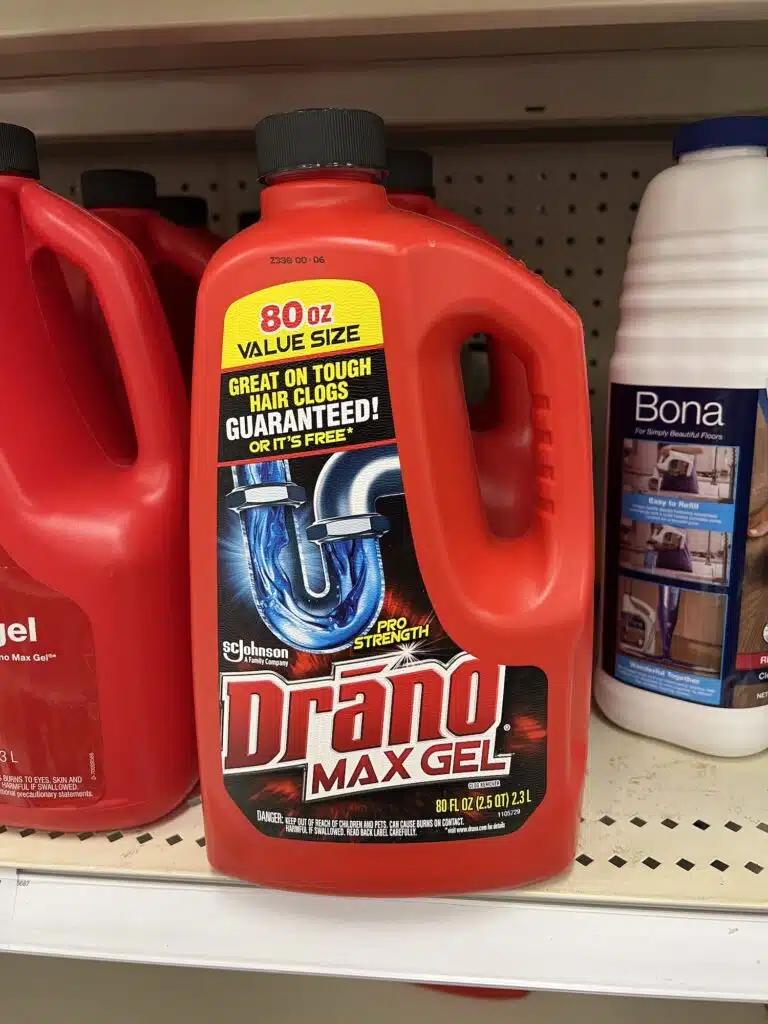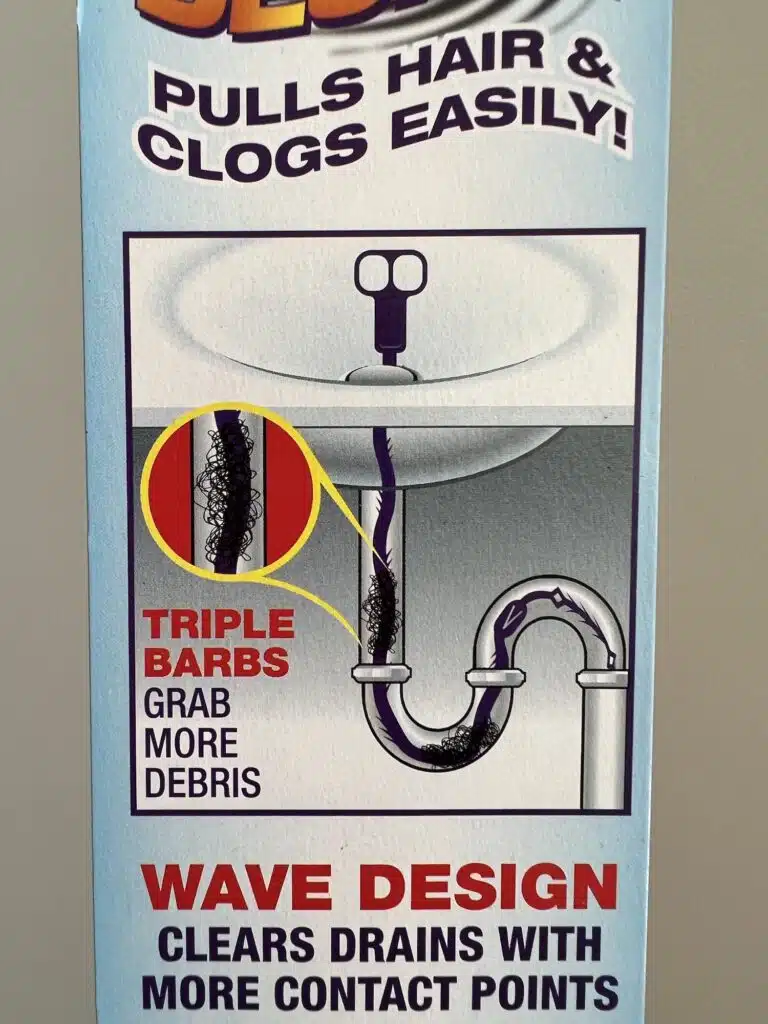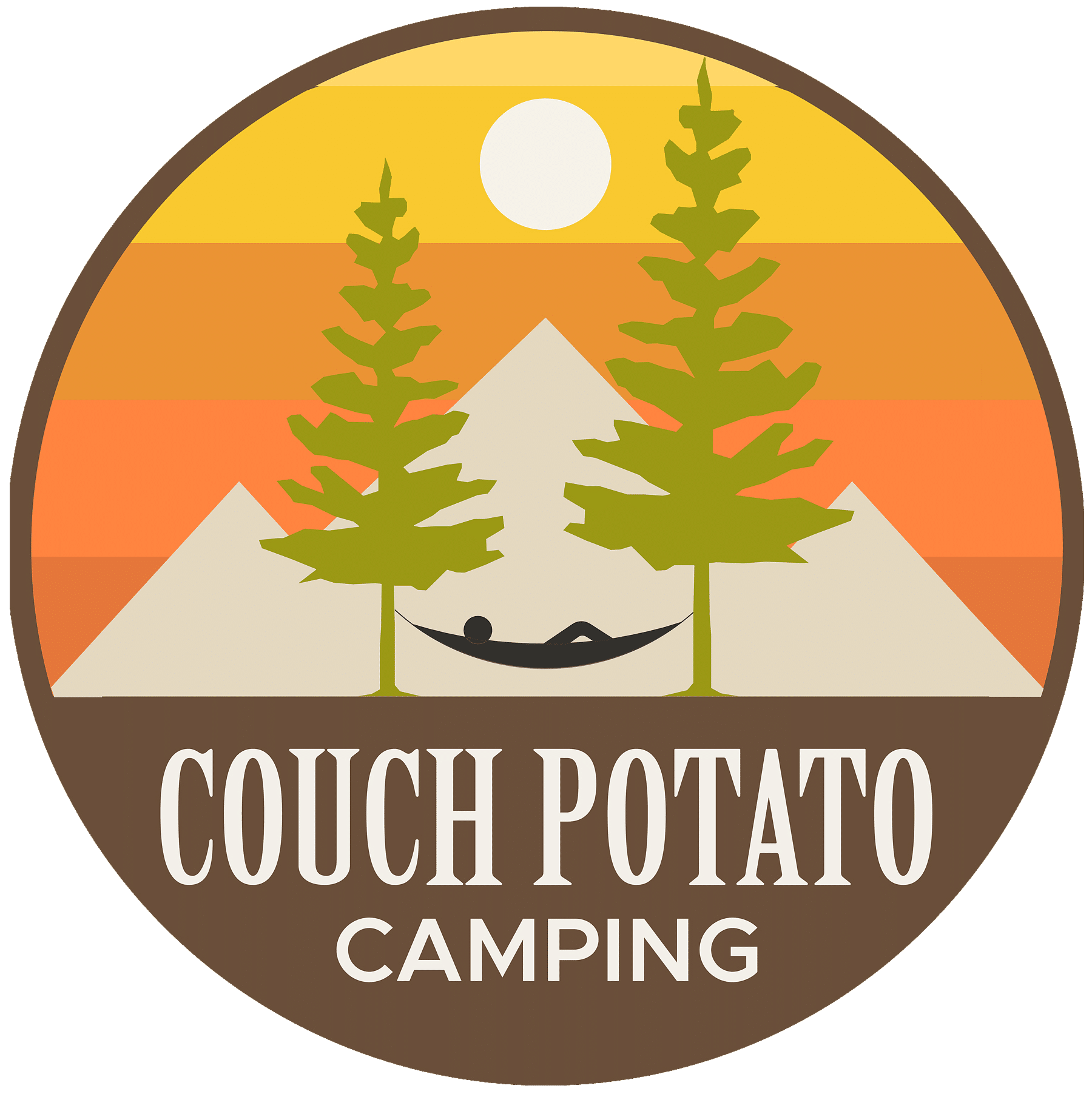I will never forget the first time our RV shower became clogged. One day I took a shower and the water was backing up and not draining out of the shower tray. As it continued to rise higher around my ankles, I knew that I had to turn off the shower immediately otherwise the bathroom would flood.
I instantly wondered, “Can I use Drano in my RV?” At home, this would be the first thing that we would try to clear a clog. But RV plumbing setups are much different and more sensitive. What were we going to do?
After much research, we figured out how to unclog our RV shower and RV toilets from clogging.

Why Drano Could Damage Your RV Plumbing
Drano is a liquid made of chemicals that is often used to unclog toilets and showers. It is one of the most popular solutions for unclogging plumbing in a home.
However, the chemicals that disintegrate and dislodge clogs of hair and gunk in your pipes at home might be too harsh for your RV’s more delicate plumbing system.
Drano Liquid Drain Cleaner ingredients include:
- Sodium Hypochlorite (Bleach)
- Sodium Hydroxide (Caustic)
Unlike a house, an RV’s plumbing system is usually lightweight plastic and rubber seals. While the metal pipes at your home can handle this corrosive remedy, the plastic pipes in your RV might not.
RV blackwater tanks also rely on bacteria and enzymes to break down solids in waste water so that they do not smell or clog your tanks. Drano will kill those beneficial bacteria, which could cause more problems.

Can I Use Drano in an RV?
Of course, you can use Drano in an RV. But should you? Probably not.
While you might need to use Drano every now and then for hard-to-remove clogs, you should do so sparingly. Use less of the liquid than you would at home, and only use it after you have tried Drano alternatives listed below.
Holding Tanks
Unlike in a home, Drano used in a toilet or shower will be washed into your holding tanks. This water, full of corrosive chemicals, will sit in your tanks and could cause damage.
Drano works by causing a heat reaction that decomposes the clog. That “hot” water would be sitting in your grey or black tanks until you empty them.
Which means you need to drain your tanks immediately after flushing water through the plumbing system after using Drano. In some situations, such as boon docking or in a campground without a dump tank, this might not be possible.
The flushed water can be caustic, too. In a home, you do not need to be in contact with the water that has been flushed to unclog the drain or toilet. However, in an RV, you need to dump that water. Which means possible exposure when opening valves and flushing your tanks.
Making the Bathroom Off Limits
In a house, you can usually treat your plumbing problem overnight. Or can use a different bathroom while the clog is being worked on.
However, in an RV, there is almost always just one bathroom. Which means time is of the essence when unclogging the plumbing.
If you need to let a drain cleaner sit overnight or for several hours, you must be prepared to use other toilet or shower facilities in the meantime.
Also, chemical drain cleaners often have a harsh odor. Definitely run the ventilation fan in your bathroom or kitchen when using these products to get the odor our and fresh air in. Because RVs are so small, you might want to have your family and pets outside so they do not have to smell the cleaner.
We personally try to avoid using Drano in our plumbing system at home because it is so caustic and the smell gives us a terrible headache. So we definitely avoid using it in our RVs, too.
A little preventative maintenance weekly or monthly can help avoid the need for Drano.
How to Prevent Clogs in an RV Drain
There are many ways that drains get clogged. Usually it is a combination of things over time that eventually creates a huge clog that won’t dislodge easily.
Some of the most common offenders are:
- Soap scum
- Hair
- Food
- Toilet Paper
- Large or unusual shaped poop (weird, but true)
- Not using enough water for flushing
Reducing these potential problems can reduce your need to unclog your plumbing system. Here are some great ideas for preventing clogs:
- Use a shower drain hair catcher. By catching hair before it goes down the drain, you can save yourself a lot of hassle.
- Don’t dispose of food down the drain. Most food can be scraped off into a trash bin to removal.
- Use only septic-safe toilet paper in your RV. This can be either RV-toilet paper or another brand that is thin and can easily decompose, such as this one.
- Add enough water in the toilet tank before flushing. Since you need to manually add water into the toilet bowl, you might not be adding enough liquids to flush down solids in your toilet. Watch our short video on the proper way to flush an RV toilet.
Non-Toxic Solutions to Remove a Clog in Your RV
There are a variety of natural or non-toxic drain cleaners that you can try using first. We personally have tried all of these DIY drain cleaners, with mixed results.
We list the unclogging methods in order of easiest to more labor intensive, plus our experiences with each method.
Boiling Water
When you suddenly have a clog in your RV and don’t have any supplies to treat it, using boiling water can be a very easy and effective method to break down the clog.
This DIY method can be used even if you are boon docking or in the middle of the forest. You will have water on hand, and can boil water on a campfire or propane stove.
Hot water can dissolve soap scum or break down solids enough to allow them to pass through your drain naturally.
Boil a half gallon to a gallon of water at a time. After it has come to a boil, let the water cool just slightly, so that it is not bubbling anymore. Pour down the drain or in the toilet and allow to sit for a minute or two.
Then flush with water afterwards to move the clog out. Repeat several times if needed.
This boiling water method is better to use as preventative maintenance. We have tried boiling water on many clogs with no success. Once a clog is too big or too thick, there is not much that the water can do.
Vinegar and Baking Soda
The next easiest and cheapest DIY drain cleaner is using vinegar and baking soda. This is a common solution for unclogging drains at home and in RVs.
Chances are you might already have vinegar and baking soda in your RV for baking or cooking. Which makes this a great solution when you unexpectedly have a clog.
When vinegar and baking soda are combined, it causes a fizzing and bubbling reaction. It is this reaction that can loosen and dislodge a clog.
We have used this method below with limited success. Again, it is better as a preventative measure rather than trying it on a major clog. However, we have found this is more effective than just boiling water alone.
DIY Drain Cleaner
- 1/2 cup baking soda
- 1 cup white distilled vinegar
Pour the baking soda into the drain first. Then, pour the vinegar over the baking soda and allow to fizz.
After the fizzing and bubbling is done, pour about a half a gallon of near-boiling water down the drain to loosen the debris.
Let sit for 5-10 minutes. Then follow with flowing water from the faucet or shower to push the clog through.
Enzyme Drain Cleaner
There are several commercial drain cleaners that use enzymes, rather than harsh chemicals, to eat away at the clog.
An enzyme-based cleaner is less harsh than those made with caustic chemicals. However, they still need to be used with caution.
You will need to purchase a product at a local store or have it on hand just in case. This probably isn’t the best solution if you are dry camping in a national park with no facilities nearby. Unless, of course, you bring a bottle of enzyme cleaner in your RV emergency kit.
We suggest the following enzyme-based cleaners:
- Earthworm Fragrance Free Drain Cleaner has been rated the best natural drain cleaner by Real Simple magazine in 2022. It does not create heat as a method of unclogging the drain. It is septic safe. (Also available on Walmart.com)
- Caravan RV Sensor and Tank Cleaner is another enzyme-based cleaner meant for maintenance. However, it does state that it can help to clear up clogs.
We have had limited success with enzyme-based drain cleaners in the past. They do actually work on small to medium clogs. However, if you have a major clog, this might not be the most effective solution.
Drain Snake
A drain snake is a long piece of plastic with teeth along the sides that is physically inserted into a drain or toilet. Pushing and pulling the drain snake in the pipes can help to dislodge whatever is clogging the plumbing system.

While this method requires a more hands-on approach, it is the most effective method that we have found.
Some people are grossed out by having to remove the drain snake after plunging and what could be attached to the plastic. However, the item is so thin and narrow that we have not really ever had major stuff come out attached to the drain snake. Usually it is dislodged and flows away with the water.

Plus, you throw away the drain snake afterwards, so there is no need to clean it after using.
Another solution is drain cleaner sticks which can only be used in your kitchen sink drain, and are best for small clogs.
A drain snake is cheap (we have found them at the Dollar Tree), takes up almost no room and weighs almost nothing. It is perhaps the best non-toxic solution to getting rid of clogs in your RV.
Related RV Maintenance Articles:
Conclusion
The answer to the question “Can I use Drano in an RV?” is more complicated than a simple yes or no. Ideally, you will want to try to remove any clog in your camper’s sink, shower or toilet with a more natural and non-toxic method before using a chemical drain cleaner. However, if you find yourself in a situation when only Drano will work, you can proceed cautiously by only using when absolutely necessary, using the smallest amount possible, and taking precautions for dumping your tanks afterwards.
